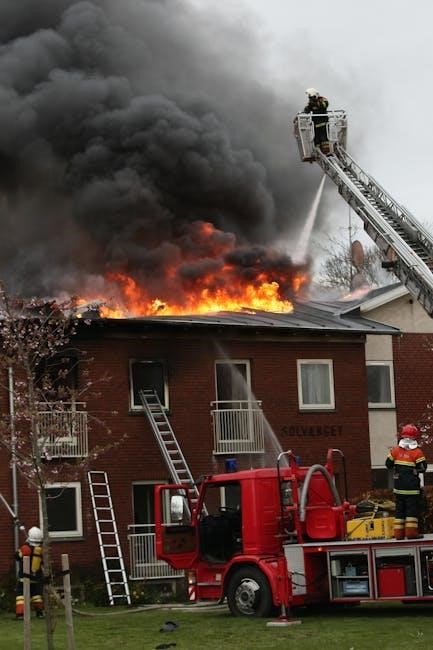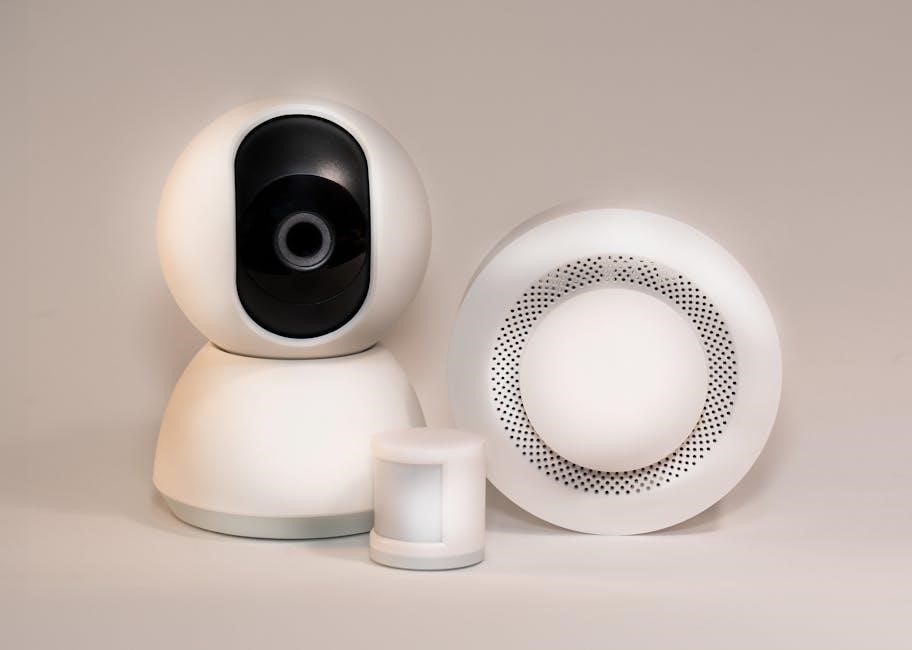Firex Smoke Alarm User Manual: A Comprehensive Guide
Welcome! This comprehensive guide provides essential information regarding your Firex smoke alarm. It covers everything from installation and operation to maintenance and troubleshooting. Read carefully to ensure optimal safety and performance of your device.
Firex smoke alarms are designed to provide early warning of fire, increasing your family’s chance of escape. This user manual offers detailed instructions for installation, operation, and maintenance, ensuring your smoke alarm functions effectively.
Firex offers various models, including ionization and multi-criteria alarms that detect both smoke and carbon monoxide. Understanding the features of your specific model is crucial. This manual will guide you through the specifics.
Remember, a smoke alarm is only effective if properly installed and maintained. Regular testing and battery replacement are essential. This manual includes step-by-step instructions for these tasks. It’s important to familiarize yourself with the alarm signals to differentiate between smoke and carbon monoxide detection.
By following the instructions in this manual, you can maximize the protection offered by your Firex smoke alarm and ensure the safety of your home and loved ones. Always refer to this manual for any questions or concerns regarding your smoke alarm.
Understanding the Importance of Smoke Alarms
Smoke alarms play a pivotal role in fire safety, acting as your first line of defense against the devastating effects of fire. They provide crucial early warning, giving you and your family precious time to escape safely. Without a working smoke alarm, you’re significantly more vulnerable.
Statistics show that homes with smoke alarms have a much higher survival rate in the event of a fire. Smoke alarms are designed to detect smoke particles in the air, triggering an audible alarm that alerts occupants to the danger. Every second counts when a fire breaks out.

It’s not enough to simply have smoke alarms; they must be properly installed, maintained, and tested regularly. A non-functioning smoke alarm is as good as having no alarm at all. Remember, smoke rises, so proper placement is vital for effective detection.
Interconnected smoke alarms offer enhanced protection, as they all sound simultaneously, regardless of where the fire originates. By understanding the importance of smoke alarms and taking the necessary steps to ensure they are working correctly, you can significantly increase your safety and protect your loved ones.
Firex Smoke Alarm Models: An Overview
Firex offers a range of smoke alarm models designed to meet diverse needs and preferences. Understanding the features of each model is crucial for selecting the right one for your home. Some models are ionization-based, while others utilize photoelectric technology, and some combine both.
Ionization smoke alarms are generally more responsive to fast-flaming fires, while photoelectric alarms are better at detecting slow, smoldering fires. Multi-criteria alarms, like the FADC230, detect both smoke and carbon monoxide, providing comprehensive protection.
Many Firex alarms come with convenient features like easy-access battery doors and false alarm control, minimizing nuisance alarms caused by cooking or steam. Some models are designed for AC power with battery backup, ensuring continuous operation even during power outages.
When choosing a Firex smoke alarm, consider your specific needs and the layout of your home. Interconnected models are ideal for larger homes, providing early warning throughout the entire dwelling. Always refer to the product specifications for detailed information on each model’s capabilities and limitations. Ensuring you select the appropriate model is vital.

Installation Guide
Proper installation is critical for your Firex smoke alarm to function effectively. Follow the step-by-step instructions carefully to ensure correct placement and wiring, maximizing your home’s fire safety.
Choosing the Right Location for Your Smoke Alarm
Selecting the appropriate location for your Firex smoke alarm is paramount for early fire detection. Install alarms inside each bedroom, outside sleeping areas, and on every level of your home. A smoke alarm will not promptly detect a fire EXCEPT in the area or room in which it is installed.
Avoid placing alarms near windows, doors, or air vents, as drafts can interfere with smoke reaching the sensor. Do not install in kitchens or bathrooms, where steam or cooking fumes may cause false alarms. Cigarette smoke will not normally set off the alarm unless blown directly into it.
Interconnected smoke alarms installed in every room and on every level provide the best protection. Remember, a well-placed smoke alarm is your first line of defense against fire.
Step-by-Step Installation Instructions
Before you begin, ensure you have all necessary tools: a screwdriver, drill (if needed), and mounting hardware included with your Firex smoke alarm. First, determine the mounting location, ideally on the ceiling or high on a wall, following the guidelines for choosing the right location.
Next, use the mounting bracket as a template to mark the screw holes. Drill pilot holes if installing on hard surfaces. Attach the mounting bracket securely to the ceiling or wall. Connect the alarm to the wiring harness, ensuring a firm connection.
Finally, attach the smoke alarm to the mounting bracket by twisting it into place. Test the alarm by pressing the test button. The test button checks smoke alarm operation. Ensure the alarm sounds loudly and clearly. If installing a single-station alarm, cover any unused wires with electrical tape.
Interconnecting Smoke Alarms: Best Practices
Interconnecting smoke alarms provides an added layer of safety, ensuring that if one alarm detects smoke or carbon monoxide, all interconnected alarms will sound. This is particularly crucial in larger homes or those with multiple levels. It is useful in the area or room in which it is installed.
When interconnecting Firex smoke alarms, use the appropriate wiring (typically orange or white cable) as specified in the alarm’s manual. Ensure all alarms are on the same electrical circuit and that the wiring connections are secure. A smoke alarm will not promptly detect a fire EXCEPT in the area or room in which it is installed.
After installation, test all interconnected alarms to verify they activate simultaneously. Regular testing is essential to confirm the system’s functionality. Interconnected smoke alarms installed in every room and on every level of the home is important.

Operation and Testing
Understanding how your Firex smoke alarm operates and how to properly test it is crucial for your safety. Regular testing ensures the alarm is functioning correctly and provides early warning in case of a fire.
Understanding Alarm Signals: Smoke and Carbon Monoxide Detection
Your Firex smoke alarm may be equipped with both smoke and carbon monoxide (CO) detection capabilities. It’s vital to differentiate between the alarm signals for each hazard to respond appropriately. A smoke alarm typically sounds a loud, continuous, and repeating pattern.
This indicates the presence of smoke, potentially from a fire. Evacuate immediately if you hear this alarm. For CO detection, the alarm may sound a different pattern, often four beeps followed by a pause, repeating continuously.
CO is a colorless, odorless, and deadly gas. If the CO alarm sounds, evacuate to fresh air and call emergency services or a qualified professional. Some alarms may also have a voice warning feature, clearly stating “Fire!” or “Carbon Monoxide!” Familiarize yourself with the specific signals of your Firex model by consulting the user manual to ensure a swift and appropriate reaction.
Testing Your Firex Smoke Alarm Regularly
Regular testing of your Firex smoke alarm is crucial to ensure it’s functioning correctly and can provide timely warnings in case of a fire. It is recommended to test your smoke alarm at least once a month. To test, locate the test button on the alarm unit. Press and hold the test button until the alarm sounds.
The alarm should emit a loud, consistent beep. If the alarm doesn’t sound or the sound is weak or intermittent, check the battery or power supply. If replacing the battery doesn’t resolve the issue, consult the user manual or contact Firex customer support for further assistance.
Remember, a properly functioning smoke alarm is your first line of defense against fire hazards. Consistent testing ensures your alarm is ready to protect you and your family. Document the date of each test for your records.
Interpreting Test Results
After testing your Firex smoke alarm, understanding the results is crucial for ensuring its proper function. A successful test is indicated by a loud, clear, and consistent beeping sound when the test button is pressed. This confirms that the alarm’s sensor, horn, and battery (if applicable) are working correctly. If the alarm sounds weak, distorted, or doesn’t sound at all, it indicates a potential problem.
A weak sound often suggests a low battery, requiring immediate replacement. If replacing the battery doesn’t fix the issue, the alarm may be malfunctioning and need to be replaced. No sound at all could mean a dead battery, a disconnected power source (for hardwired alarms), or a faulty unit.
For interconnected alarms, test each unit individually. If one unit fails to sound, investigate its power and connection. Replace any malfunctioning alarms immediately with a comparable Firex model to ensure continuous protection. Keep a record of your test results for future reference.

Maintenance and Troubleshooting
Maintaining your Firex smoke alarm ensures its reliability. This section covers battery replacement, cleaning procedures, and solutions to common issues like false alarms and malfunctions, keeping your alarm functioning optimally for years to come.
Battery Replacement Procedures
Replacing the battery in your Firex smoke alarm is a crucial maintenance task. A low battery can compromise the alarm’s functionality, leaving your home vulnerable.
First, ensure you have the correct replacement battery. Refer to your alarm’s model number and the user manual for specifications. Typically, Firex alarms use standard alkaline batteries.
To replace the battery, gently open the battery compartment, usually located on the alarm’s exterior. Remove the old battery and dispose of it properly, following local regulations for battery disposal.
Insert the new battery, ensuring correct polarity. The positive (+) and negative (-) terminals are usually marked in the compartment. A secure connection is essential for reliable operation.
Close the battery compartment securely. Test the alarm by pressing the test button. A loud, clear sound indicates successful battery replacement. If the alarm remains silent, double-check the battery’s polarity and contact customer support for assistance. Regular battery replacement is vital for continuous protection.
Cleaning Your Smoke Alarm
Regular cleaning is essential to maintain the optimal performance of your Firex smoke alarm. Dust and debris can accumulate inside the alarm, potentially causing false alarms or hindering its ability to detect smoke effectively.
Before cleaning, disable the alarm to prevent unnecessary noise. Consult your user manual for specific disabling procedures, if applicable. Generally, this involves removing the battery or temporarily disconnecting the power supply.
Use a soft brush attachment on your vacuum cleaner to gently remove dust from the exterior of the alarm. Pay close attention to the vents and openings where dust tends to accumulate.

For stubborn dirt, lightly dampen a soft cloth with water and gently wipe the alarm’s surface. Avoid using harsh chemicals or abrasive cleaners, as they can damage the alarm’s sensitive components.
Allow the alarm to dry completely before reassembling and re-energizing it. Test the alarm after cleaning to ensure it is functioning correctly. Regular cleaning, combined with testing, will help maintain your smoke alarm’s reliability.
Troubleshooting Common Issues: False Alarms and Malfunctions
False alarms and malfunctions can be frustrating. Here’s how to troubleshoot common issues with your Firex smoke alarm.
False Alarms: Common causes include dust, steam, cooking fumes, or insects. Clean the alarm thoroughly as described in the maintenance section. Ensure proper ventilation during cooking. If the problem persists, relocate the alarm away from the source of the false alarms;
Low Battery Chirps: This indicates the battery needs replacing. Replace it immediately with a fresh battery of the correct type. Refer to your manual for battery specifications.
Alarm Doesn’t Respond to Test Button: Check the battery first. If the battery is good, the alarm may be malfunctioning and needs replacement. Contact Firex customer support for assistance.
Intermittent Alarms: Check for loose wiring connections if the alarm is hardwired. Ensure the alarm is securely mounted. If the problem persists, the alarm may be faulty.
If you’ve exhausted these steps and your alarm continues to malfunction, consult a qualified electrician or contact Firex for further assistance.

Safety Information and Warnings
This section contains crucial safety precautions and warnings related to your Firex smoke alarm. Understanding these limitations and guidelines is essential for ensuring your safety in the event of a fire.
Important Safety Precautions
Always adhere to the following safety precautions to ensure the proper functionality of your Firex smoke alarm and protect your household. It is vital to install, use, and maintain your smoke alarms according to the provided instructions. Remember, a smoke alarm is only effective if properly installed and maintained.
Never disable or remove the battery from your smoke alarm unless necessary for replacement. Ensure that the replacement battery is of the correct type and voltage, as specified in this manual. Test the alarm immediately after replacing the battery to confirm proper operation.
Do not ignore any alarms. Investigate the source of the alarm immediately. It could be a sign of a real fire or carbon monoxide leak. Familiarize yourself with the different alarm signals for smoke and carbon monoxide detection.
Regularly test your smoke alarm to ensure it is functioning correctly. Use the test button to check the alarm’s operation. If the alarm fails to sound during the test, refer to the troubleshooting section of this manual.
Limitations of Smoke Alarms
Understanding the limitations of your Firex smoke alarm is crucial for ensuring home safety. Smoke alarms are designed to provide an early warning of fire, but they are not foolproof and have certain limitations that homeowners should be aware of.
Smoke alarms can only detect smoke that reaches the sensor. Therefore, a fire in a remote area, or behind closed doors, may not be detected promptly. For optimal protection, install interconnected smoke alarms on every level of your home and in each bedroom.
Smoke alarms may not be effective if the occupants are impaired or unable to hear the alarm. This includes individuals who are deaf or hard of hearing, or those under the influence of drugs or alcohol. Consider installing specialized alarms with visual or tactile alerts for these individuals.
Smoke alarms are designed to minimize false alarms, but they can still occur due to cooking smoke, steam, or dust. Avoid placing smoke alarms near kitchens or bathrooms to reduce the likelihood of nuisance alarms. Regularly clean your smoke alarm to prevent dust buildup.
What to Do in Case of a Fire
Knowing what to do when a fire alarm sounds is critical for the safety of you and your family. A fire can spread rapidly, so acting quickly and calmly is essential.
Evacuate immediately: When the smoke alarm sounds, don’t hesitate. Immediately evacuate the building. Don’t stop to collect belongings. Get everyone out as quickly as possible.
Feel doors before opening: Before opening any door, feel it with the back of your hand. If it’s hot, do not open it. Use an alternative escape route.
Stay low to the ground: Smoke rises, so stay low to the ground to avoid inhaling smoke and toxic fumes. Crawl if necessary.
Have a meeting point: Establish a designated meeting point outside your home where everyone can gather after evacuating. This ensures everyone is accounted for.
Call for help: Once you are safely outside, call the fire department immediately from a neighbor’s phone or a cell phone.
Never go back inside: Once you’re out, never go back inside for any reason. Let the firefighters handle the situation.

Additional Resources
For further assistance, consult these resources. Find contact information for Firex customer support, warranty details, and frequently asked questions. We are here to help ensure your safety and satisfaction.
Contacting Firex Customer Support
If you encounter any issues with your Firex smoke alarm or have questions that are not addressed in this manual, our dedicated customer support team is available to assist you. We understand the importance of a functioning smoke alarm and are committed to providing prompt and helpful assistance.
You can reach Firex customer support through several channels. Our website offers a comprehensive FAQ section that may answer your questions immediately. Alternatively, you can contact us via email for detailed inquiries or technical support. For urgent matters, we provide a toll-free phone number where you can speak directly with a customer service representative.

Our support team can assist with troubleshooting, warranty claims, and general inquiries about Firex products. When contacting us, please have your smoke alarm model number and purchase date readily available to expedite the support process. We value your safety and strive to resolve any issues quickly and efficiently.
Warranty Information
Your Firex smoke alarm is backed by a limited warranty against defects in materials and workmanship. This warranty provides you with specific legal rights and may also include other rights that vary depending on your location. Please retain your proof of purchase, as it will be required to validate any warranty claims.

The warranty period typically extends for a specified duration from the date of original purchase. During this period, Firex will, at its option, repair or replace any defective smoke alarm free of charge. This warranty does not cover damage resulting from misuse, neglect, improper installation, or unauthorized repairs.
To initiate a warranty claim, contact Firex customer support with details of the issue and your proof of purchase. You may be required to return the defective unit for inspection. Firex will cover the cost of return shipping if the defect is covered under warranty. Please refer to the complete warranty statement included with your product for full details and limitations.




Leave a Reply
You must be logged in to post a comment.